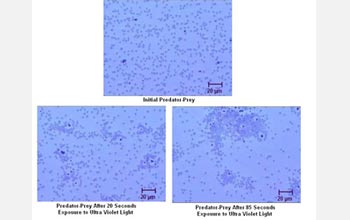Multimedia Gallery
Particle motion driven by light provides a theory for independent movement of nano-machines.
The study of bacteria offers some intriguing theories for building autonomous nano-motors. One theory involves phototaxis--particle motion driven by light in which particles move towards or away from the region of highest light intensity. Movement depends on the nature of the ions given off by a lighted particle and the charge of the particle. The phenomenon can lead to biomimetic cooperative behavior, such as one in which some particles act as "predators" and others as "prey," very much like white blood cells chasing down a bacterium. The design of "smart" autonomous nano-robots could take on similar characteristics, moving independently in a needed direction by harvesting energy from light, glucose or other abundant fuels in biological or organic systems. Here, two different particles engage in phototaxis "predator-prey" movement. Dark silver chloride particles when stimulated by UV light emit positively charged ions. These ions propel the movement of the silver chloride particles, but they also cause attraction of the lighter colored silica particles. Consequently, the "prey" particles are eventually surrounded by "predators." The silver chloride particles are shown first in a neutral state, and then they are photographed after 20 seconds of exposure to UV light and again after 85 seconds of exposure. The exposure causes them to be surrounded by silica particles that are attracted by the ions. The results cause researchers to hypothesize that nano-engines using similar technologies may not be that far away.
Credit: Michael E. Ibele, Thomas E. Mallouk, and Ayusman Sen, Angew. Chem., in press
Images credited to the National Science Foundation, a federal agency, are in the public domain. The images were created by employees of the United States Government as part of their official duties or prepared by contractors as "works for hire" for NSF. You may freely use NSF-credited images and, at your discretion, credit NSF with a "Courtesy: National Science Foundation" notation.
Additional information about general usage can be found in Conditions.
Also Available:
Download the high-resolution JPG version of the image. (48 KB)
Use your mouse to right-click (Mac users may need to Ctrl-click) the link above and choose the option that will save the file or target to your computer.
Related story: "Fantastic Voyage" Not So Far-fetched



